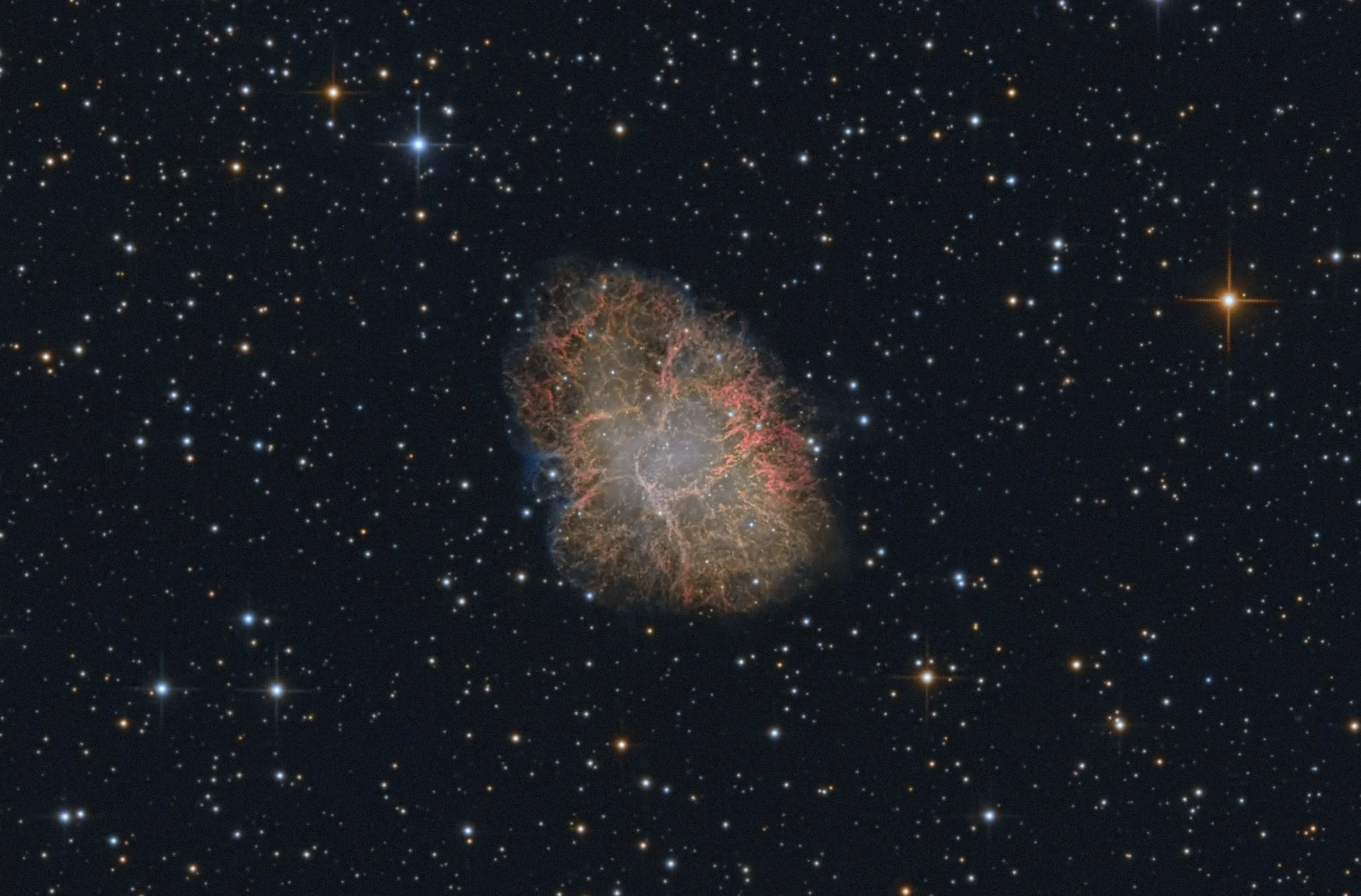
AAPOD2 Image Archives
Sort 2025 By Month: January | February | March | April | May | June | July | August | September | October | November | December
M1 - Crab nebula
M1, the Crab Nebula, is a supernova remnant located in the constellation Taurus, approximately 6,500 light-years away. This cosmic cloud of gas and dust marks the explosive death of a massive star, first observed as a supernova in 1054 CE by astronomers across the globe. At its core lies a rapidly spinning neutron star, or pulsar, emitting beams of radiation that sweep across space like a lighthouse, energizing the surrounding nebula and causing it to glow brightly in multiple wavelengths.
Observed from Hofheim near Frankfurt, Germany, M1 reveals a fascinating blend of structure and color. The filaments of the nebula, rich in hydrogen and helium, are interwoven with heavier elements like oxygen and sulfur, ejected during the supernova. The nebula continues to expand at nearly 1,500 kilometers per second, offering a dynamic view of the aftermath of stellar destruction. Despite its tumultuous origin, the Crab Nebula stands as a beacon of cosmic renewal, illuminating the intricate cycles of life and death in the universe.
M1 - A supernova remnant
The iconic Crab Nebula, also known as M1, a celestial masterpiece captured in the vast expanse of the Taurus constellation. This intricate nebula, born from a spectacular supernova explosion witnessed by astronomers in the year 1054 AD, stands as a testament to the dynamic forces shaping our cosmic neighborhood.
M1, the first entry in Charles Messier's catalog of astronomical objects, emanates from the remnants of a massive star that met its explosive fate. Located approximately 6,500 light-years away, the Crab Nebula spans about 11 light-years in diameter, showcasing the aftermath of the stellar explosion.
In the heart of the Crab Nebula resides a pulsar—a rapidly rotating neutron star that emits beams of radiation akin to a celestial lighthouse. This pulsar, a mere 20 kilometers in diameter, powers the nebula's glow and serves as a cosmic time capsule, preserving the memory of the cataclysmic event that gave birth to this celestial wonder.
Captured through the lens of astronomical observation, this image of the Crab Nebula unravels the intricate filaments of ionized gas and energized particles, offering a glimpse into the cosmic forces at play. The Crab Nebula's ongoing expansion and evolution make it a captivating subject for astronomers studying the life cycles of stars and the dynamic nature of our universe.
As we explore the luminous tendrils of the Crab Nebula, we are reminded of the perpetual dance between destruction and creation in the cosmos, inviting us to contemplate the beauty that arises from the remnants of stellar demise.
The Crab Nebula
Image Description and Details : The Crab Nebula (catalogue designations M1, NGC 1952, Taurus A) is a supernova remnant in the constellation of Taurus. Corresponding to a bright supernova recorded by Chinese astronomers in 1054, the nebula was observed later by English astronomer John Bevis in 1731. The nebula was the first astronomical object identified with a historical supernova explosion.
At an apparent magnitude of 8.4, comparable to that of Saturn's moon Titan, it is not visible to the naked eye but can be made out using binoculars under favourable conditions. The nebula lies in the Perseus Arm of the Milky Way galaxy, at a distance of about 6,500 ly from Earth. It has a diameter of 11 ly.
At the center of the nebula lies the Crab Pulsar, a neutron star 28–30 kilometres across with a spin rate of 30.2 times per second, which emits pulses of radiation from gamma rays to radio waves.
Copyright: Ruben Barbosa
Crab Nebula : M1
A RGBHOO version of M1, Crab Nebula. Total integration time is 12 hours 19 minutes (R 2h 6m, G 2h, B 13m, Ha 4h 30m Oiii 2h 40m), image has been cropped.






